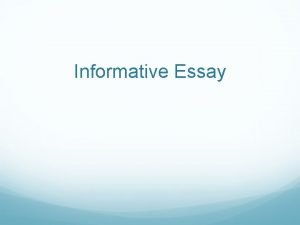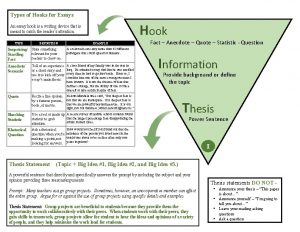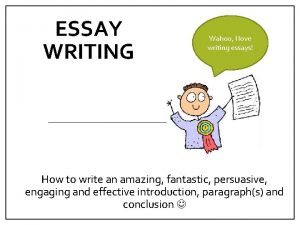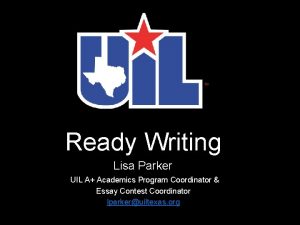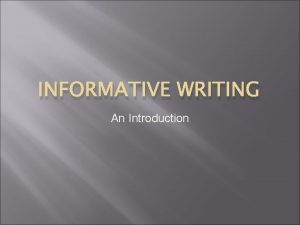WRITING INFORMATIVE AND EXPOSITORY ESSAYS CRAFTING AN INFORMATIVE








- Slides: 8

WRITING INFORMATIVE AND EXPOSITORY ESSAYS CRAFTING AN INFORMATIVE ESSAY ABOUT THE HOLOCAUST

ESSENTIALS FOR WRITING INFORMATIVE ESSAYS: • Introduce a topic; organize ideas, concepts, and information. • Explain and develop your topic with relevant information like quotes, facts, examples, statistics, etc. . • Use transitions to explain facts and develop your essay with words like (similarly, therefore, likewise, specifically, for example, considering this, including, alternatively, etc. . ) • https: //www. msu. edu/~jdowell/135/transw. html

PICKING A TOPIC: • Of the 4 topics which one appeals to you the most? Lives of prisoners, survivors, brainwashed guards, concentration camps in general? • What do you want to know about it? This will be your research question. • Ex. Research question: What was life like for prisoners of Japanese internment camps in the US? How did the US justify the evacuation of 120, 000 Japanese people in 1942 and putting them in concentration camps? How were children affected by this? • Where could I find relevant, reliable information to my topic? • Ushistory. org, PBS. org/childrenofthecamp

CONDUCTING EFFECTIVE RESEARCH: • Always use a trusted search engine like Google when conducting research. • Use specific key words related to your topic: treatment of children during the holocaust, lasting effects on holocaust survivors, etc. • Do not use Wikipedia, rather, check out sites that have domains that end in. org, . edu, or. gov --. com can work too, but click around on the website and be sure it is credible (who updates the site, where is their information from? ) • Interviews with holocaust survivors can also be very helpful in your research. • When referring to any piece of your research in your essay you must state where is came from. For example: The article entitled “Displaced Persons” featured on the website USHMM. org states, “…” According to The Diary of Anne Frank, “…” • See “Avoiding Plagiarism” slide

FORMAT FOR INTRODUCTION AND THESIS First you need a hook—something to grab your reader’s attention. Perhaps a disturbing fact about the holocaust that you can put into your own words—or an interesting quote about the holocaust. Ex. America is known as the land of the free, however, in 1942 those who were of Pacific. Asian descent were not afforded that right and were taken prisoner in their own country. Ex. During the Great Depression, millions of people lost jobs, and families struggled to find financial footholds. Thesis: What are you going to say in your paper? What important points are you going to explain? Thesis Example 1: The American government was led by fear to violate the civil rights of Japanese-Americans, economically damage the lives they had built, and mentally disturb thousands of people. Thesis Example 2: Everybody learned the importance of being resourceful, while also keeping hope for the future and growing more unified and patriotic as a country.

BODY PARAGRAPHS • Three points you are going to discuss will be the topics of each of your body paragraphs. For example: • For my Japanese example: 1 paragraph about civil rights violation, the next about the loss of money and businesses, and last the emotional and mental toll it took on the prisoners. • Holocaust/TDA Example: • What was life like right before Jews were taken to the camps. How did the Nazi occupation of a town affect everyday life for Jews? • Next would be about the way in which Jews were taken from their villages—this will be explained through explanation and quotes. • Then I would discuss Hannah, Schmuel, and Gitl’s little knowledge about the Nazis and the belief they were safe in their Shtetl, however, they still ended up being imprisoned by the Nazis.

CONCLUSION: Look back to your introductory paragraph and reflect on what you have written in your essay. Your conclusion should be about 4 -6 sentences that restate your introduction in slightly different words. Ex. While America is primarily known for the freedom it affords to its citizens, during 1942 Japanese-Americans suffered emotionally and financially for actions they were not responsible for. Refer to the conclusion paragraph on student exemplar Great Depression essay.

AVOIDING PLAGIARISM • Plagiarism is taking someone else’s work and passing it off as your own without giving credit to the original author. • Plagiarism is illegal because you cannot take another person’s work or intellectual property without their permission or without citing it. • You cannot copy and paste information off the internet or from books without citing it! This will result in an automatic zero for your essay! • Put your ideas and information in your own words, than back it up with quotes that confirm what you’re saying. • Ways to avoid plagiarism are using quotations and in-text citations. Example: According to the article United States and the Holocaust, “The US Department of policies made it very difficult for refugees to obtain entry visas” (USHMM. ORG).

